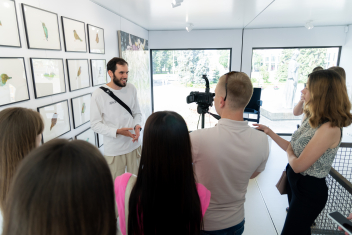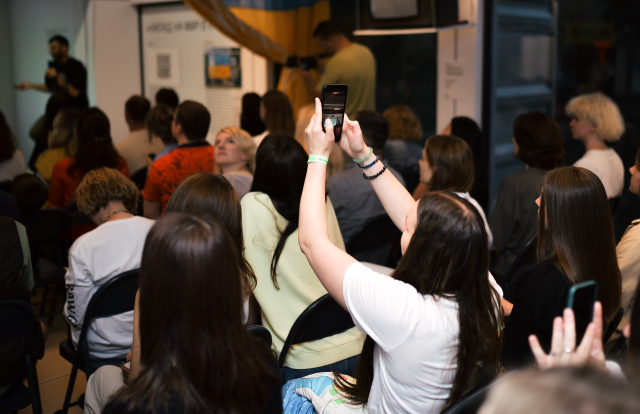
The war in Ukraine has dealt a significant blow to every aspect of the country’s life, including its cultural institutions. The constant shelling and rocket attacks destroyed countless priceless art objects along with the museums that housed them. Many such institutions were forced to evacuate to the country's western regions or find new buildings to house their collections, a process that always requires significant investments. The Module of Temporality (MOT) project set out to help those art-refugees.
MOT is an international art project and one of the largest of its kind in the 2023 Ukraine. It is a temporary cultural space initiated by an international team and Don't Take Fake. MOT’s staff features 28 artists from 10 countries, including Fabrice Bousteau, a renowned journalist, writer, and art critic.
In this article, we will look at how the Module of Temporality helps the Ukrainian government in restoring the art institutions and why those efforts are important in the current situation.
The Importance of Rebuilding Ukraine's Damaged Art Institutions

Art institutions play a key role in preserving and promoting cultural heritage. They help showcase artifacts, art, documents, and other objects that illustrate the culture’s history, fostering a sense of community between otherwise disparate elements of society. This is essential not only for saving the culture’s values for future generations, but also for reinforcing the identity of modern society. Art institutions create an opportunity for a deeper understanding of our roots and contribute to global cultural diversity.
Restoration of art institutions in Ukraine usually begins immediately in the aftermath of an attack or after the area’s liberation by the Ukrainian armed forces. However, museums do not always have funds for restoration due to understandably limited state support, bureaucratic obstacles, and the large amount of work involved. Therefore, they often look for various support programs and sponsors in Ukraine and abroad.
How Innovative Approach Changes the Landscape: The Module of Temporality (MOT) Case Study

Module of Temporality is a great example of a project dedicated to revival of the art institutions in Ukraine. MOT’s art installations were displayed in such Ukrainian cities as Lviv, Kyiv, Lutsk, and Dnipro, attracting more than 56,000 visitors in total. All the money generated by the project, which is more than 10 million hryvnias or about $250,000, was sent to form a fund. In turn, the fund was used to renovate art institutions affected by the war.
Nevertheless, it’s difficult to choose which of the war-affected institutions need help first. Many museums and galleries throughout Ukraine have been damaged by the war in one way or another, from museums in the north of the country and the capital to countless destroyed buildings in the east. Proper assessment is crucial in terms of the revival of art galleries in Ukraine. That’s why, for prioritization, the project used the UNESCO list and data from the Ministry of Culture and Information Policy of Ukraine.
The project’s experts identified the damaged museums and galleries most affected by the war (as of September 2023). The project also accepted applications from institutions that were not included in the official lists but required support in their rebuilding efforts.
Based on the results of the assessment, it was decided to prioritize support for the Hryhoriy Halahan Chernihiv Regional Art Museum. On March 6, 2022, as a result of artillery shelling in Chernihiv, the museum building was damaged by an explosion extremely close to its central facade. The main damage was done to the basement, first and second floors. The premises of the first and second floors are stock storage facilities. Staff rooms and offices were partially damaged as well.
It has already been determined that the first tranche will help the museum with installing new windows and frames, as well as refurbishing the shelter hall and restoration workshop. However, additional calculations are still in process to assess the scope of the remaining repair work. According to the museum's application paper, about UAH 14 million, or more than $350,000, is required to fully repair the damage.
Work is currently underway, but it is not enough. Despite various initiatives for the reconstruction of art institutions after the war, their effectiveness leaves much to be desired. There is no established mechanism or coherent strategy aimed at the reconstruction of art institutions in Ukraine. In turn, MOT allows funds to be directed to those most in need through civic activism and grassroots initiatives.
Final thoughts
The restoration of art institutions after the war is a complex and multi-layered process that requires a huge investment of time and effort. Module of Temporality’s initiatives is only a small step in achieving this goal, and yet it has already yielded tangible results. In the future, Algorytm NGO plans to continue working in this direction and help art institutions affected by the ongoing Russian invasion. Projects like this show how joint efforts can cope with even the most difficult tasks and give people hope, no matter what the circumstances are.
FAQ
What is the Module of Temporality (MOT), and what does it stand for?
MOT is an art project aimed at reviving the art institutions in Ukraine affected by the war. The project was initiated by the Don't Take Fake team in cooperation with international partners and artists. Algorytm NGO supported the project in Lutsk and Lviv.
How is the Module of Temporality (MOT) related to the war in Ukraine and its cultural heritage?
The project aims to create a temporary cultural space where artists can present their work, as well as to rebuild museums damaged by the war. This project helps artists to continue their activities even in conditions of continued armed aggression, and all money raised from it goes to help Ukrainian art institutions affected by the ongoing hostilities.
What artworks are displayed inside the Module of Temporality (MOT)?
The Module of Temporality features a variety of contemporary artworks. It exhibits paintings, sculptures, street art, and video installations of 28 artists from 10 countries curated by journalist, writer, and art critic Fabrice Bousteau
